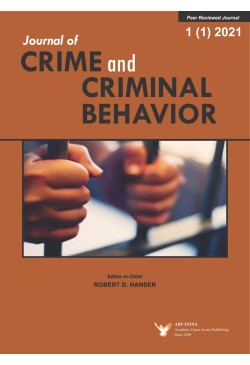
Journal of Crime and Criminal Behavior
Frequency :Bi-Annual
ISSN :2583-0244
Peer Reviewed Journal
A Comparison of the Drug Use and Protective Factors of Rural and Urban Students
Based on data from the Communities that Care Youth Survey (CCYS), the authors compare the relationships between the drug use and protective factors of rural and urban students in grades 6, 8, 10, and 12. The authors used a rural/urban index that classifies zip codes into ten categories with percentage urban/rural. Only the 2 extreme categories (those zip codes that are 90% or more rural versus 90% or more urban) were used. Findings indicated urban and rural students are similar in terms of drug use. Rural students had higher rates of alcohol use in all grades. Rural youth had higher protective factor scores.
Keywords: Rural students; drug use; alcohol use; urban students; opioid; prescription narcotics; protective factors
Craig J. Forsyth, Jing Chen, Tina H. Deshotels & Raymond W. Biggar, Jr. (2022). A Comparison of the Drug Use and Protective Factors of Rural and Urban Students. Journal of Crime and Criminal Behavior, 2: 2, pp. 67-85. https://doi.org/10.47509/JCCB.2022.v02i01.01
Views of Nigerian and U.S. College Students on Terrorism, Responses to Terrorism, and the Punishment of Terrorists
O. Oko Elechi, Eric G. Lambert & Smart E. Otu (2022). Views of Nigerian and U.S. College Students on Terrorism, Responses to Terrorirsm, and the Punishment of Terrorists. Journal of Crime and Criminal Behavior, 2: 2, pp. 87-105. https://doi.org/10.47509/JCCB.2022.v02i02.02
Police Body Cameras and Liability Insurance: The Deterrent to Police Misconduct?
Noel Out, Ben-Edet Emmanuel, Edidiong Mendie & Ihekwoba Declan Onwudiwe (2022). Police Body Cameras and Liability Insurance: The Deterrent to Police Misconduct? Journal of Crime and Criminal Behavior, 2: 2, pp. 107-129. https://doi.org/10.47509/JCCB.2022.v02i02.03
Cybercrime and the Nature of Insider Threat Complexities in Healthcare and Biotechnology Engineering Organizations
This article explores the nature of cybersecurity professionals being insider threats to their own organization, as well as the general increase in harder-to-detect threats coming from an ever-widening acceptance of third-party insiders, which organizations, biotechnology engineering, and other healthcare organizations rely on. After examining the current and emerging literature on how individuals are motivated to engage in problematic workplace behaviors as a means of gaining their specific goal or need, the paper articulates malicious cybersecurity insider threat indicators, then provides best practices for reducing the risk of these threats in healthcare and biotechnology engineering organizations.
Darrell Norman Burrell, Calvin Nobles, Austin Cusak, Marwan Omar and Lemie Gillesania (2022). Cybercrime and the Nature of Insider Threat Complexities in Healthcare and Biotechnology Engineering Organizations. Journal of Crime and Criminal Behavior, 2: 2, pp. 131-144. https://doi.org/10.47509/JCCB.2022.v02i02.04
Vagrancy and Experiences of Crime: A Case of Durban City Centre
Sazelo Michael Mkhize, Zethembe Mthokozisi Ndlovu, Khanyisile Berlinda Majola, Slindile Ngcece & Nomathamsanqa Mthethwa (2022). Vagrancy and Experiences of Crime: A Case of durban City Centre. Journal of Crime and Criminal Behavior, 2: 2, pp. 145-157. https://doi.org/10.47509/JCCB.2022.v02i02.05
Examining the Effects of COVID-19 Curtailment Measures on Criminal Activities in Southern Nigeria
Obinna J. Eze, Cyril O. Ugwuoke & Ijeoma Igwe (2022). Examining the Effect of COVID-19 Curtailment Measures on Criminal Activities in Southern Nigeria. Journal of Crime and Criminal Behavior, 2: 2, pp. 159-176. https://doi.org/10.47509/JCCB.2022.v02i02.06
Community Policing and Effective Police-Public Relations as a Panacea for Kidnapping and Hostage Taking in Nigeria
Kidnapping and hostage taking for ransom has become ubiquitous in various parts of the society and it is now more prevalent in developing societies and these has led to a security gap which the culprits are taking advantage of in perfecting their crime. This gap could be as result of inefficient and ineffective strategy been adopted by the security agents. This has resulted to a security challenge to the country and has caused the economy to dwindle. Community policing is a strategy of policing that focuses on police building ties and working closely with members of the communities. It is a policy that requires police to inherit a proactive approach to address public safety concerns. The study was anchored on functionalist theory. Community policing creates partnerships between law enforcement agency and other organizations like government agencies, community members, nonprofit service providers, private businesses and the media. The media represent a powerful pattern by which the police can communicate with the community and that enhances a cordial police-public relations. Community policing recognizes that police cannot solve every public safety problem alone, so interactive partnerships are created. The police use the public for developing problem-solving solutions and generating information. The overall assessment of community oriented policing is positive, as both officers and community members attest to its effectiveness in reducing crime and raising the sense of security in a community. Community policing calls for long-term commitment and partnership between the Police-public in curbing kidnapping and other criminal activities. The study therefore recommends that community policing skills should be integrated into the training curricula of the Nigerian police force. All personnel must become skilled in the techniques of problem solving, motivating, and team-building. Training should involve the entire agency and should include civilian personnel who can enlist participation in community meetings, help the police organization sharpen its marketing message, and incorporate sophisticated technology into the organization’s service-oriented operations.
Keywords: Community policing, Hostage taking, Kidnapping, Police-public relations
Dinne, Chinedu Ernest, Benjamin Okorie-Aja & Okunola, Rasidi Akanji (2022). Community Policing and Effective Police-Public Relations as a Panacea for Kidnapping and Hostage Taking in Nigeria. Journal of Crime and Criminal Behavior, 2: 2, pp. 177-190. https://doi.org/10.47509/JCCB.2022.v02i02.07